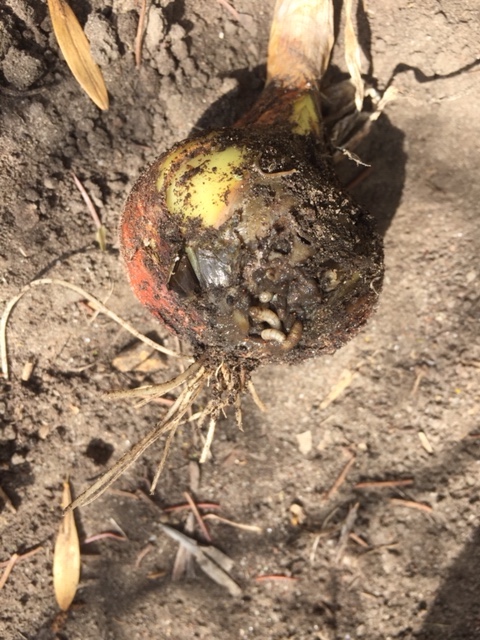
Onion root maggot
damaging
Onion root maggots (Delia antiqua) are an occasional but often serious problem when populations of this insect build up. The adult flies resemble house flies and are attracted to onions, leeks, garlic, chives and shallots by smell. The female fly emerges in mid-May to early June and lays up to 200 eggs just under the base of onion sets or onions growing from seed. The younger the plant, the greater the damage. The eggs hatch into larvae (maggots) and bore into the onion. The maggots overwinter in the soil as pupae. Onion root maggots are more abundant in wet years. Infestations can be worse in new gardens that were previously lawn or pasture. There can be two or three generations per year, depending on the weather.
Signs that onions are infested are wilting or yellowing onions that fall over. Pull an onion and look for holes in the bulb and maggots inside.
Do not use chemical insecticides to avoid killing natural predators of onion maggots which include: birds, nematodes, parasitic wasps, ground beetles and rove beetles.
Control:
- Always rotate onions – never plant in the same space for at least 3 years to avoid a buildup of this insect population.
- Plant onion sets or seeds after dandelions or caragana start blooming – early planting encourages more of the flies.
- Immediately cover onions with row cover to prevent the fly from laying its eggs. Note that this does not work if there are overwintering pupae in the soil in an area previously infested with root maggots.
- Avoid planting onions too closely – this makes it easier for the maggots to move from one onion to another.
- Plant resistant varieties: Onion maggots prefer white onions over yellow. Red onions are less susceptible and bunching onions are resistant.
- Clean up all onion debris in fall to remove the food source. Do not compost the debris.
- Diatomaceous earth may have some effect on reducing numbers if done in conjunction with culling infested onions.
- Till in fall to expose the overwintering pupae to cold and predators.
Sources:
Williams, S.; Skinner, H. (2011). Gardening, naturally: A chemical-free handbook for the Prairies. Regina, Saskatchewan: Coteau Books.
Philip, H., Mengersen, E. (1993). Insect pests of the prairies. Edmonton, Alberta: University of Alberta Press.

